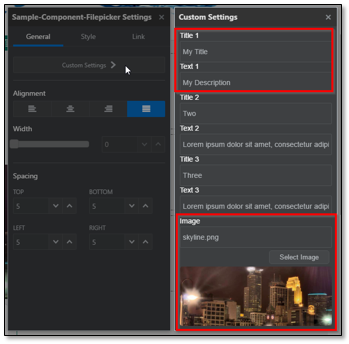What is the Content and Experience Cloud?
Oracle Content and Experience Cloud (CEC) is Oracle’s cloud platform solution for content management and delivery. It brings together Oracle’s Documents Cloud Service (Content) and Oracle’s Sites Cloud Service (Experience) to make a centrally managed platform for your business to contribute, collaborate, and share its content. It sets out to solve many of the headaches associated with content management solutions of the past and present, including:
- Poor user experience
- Security concerns
- Limited access to content and collaboration
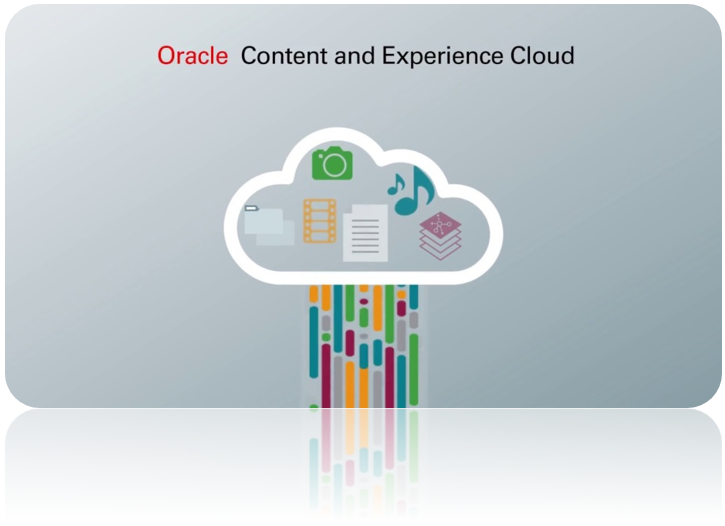
This can be drawn as a parallel to Oracle’s motto throughout marketing their Documents Cloud Service: “Simple, Secure, Everywhere”.
In this post, I’m going to detail how Content and Experience Cloud meets each of these challenges, describing some of the features available. I’ll also give an overview of some of the custom development efforts I’ve achieved in the past few weeks, and what kind of enterprise applications could be developed using similar approaches.
Solving the Problems with Traditional Content Management Systems – Including Oracle WebCenter.
User Experience – Low user adoption and poor user experience have been major challenges facing legacy content management systems. Oracle Content & Experience Cloud aims to remedy some of these problems in a number of ways.
- Mobile, tablet, and desktop access:
- Oracle adopted a mobile-forward design pattern for CEC interfaces to adjust for devices that can be used anywhere.
- View, edit, and manage files from any of these devices with the applications Oracle has provided. All desktop and mobile application downloads can be found together on the “Download Apps” page of your CEC service interface, while mobile apps can also be found on both major mobile app markets (Android App and iPhone App).
- Share files or folders simply, with the ability to assign access levels to limit what can be done to the content.
- Conversations can be started about folders, files, or a separate topic altogether.
- Annotations can be made on specific parts of a document.
- Documents can be attached to conversations.
- Conversations can be accessed from the web, desktop, and mobile apps.
- Integrations exist out of the box with programs like Microsoft Word and Excel for syncing documents or spreadsheets to the cloud. A UI overlay will appear on the program, visually confirming the document as it syncs to the cloud, and expands to provide users actions like viewing content access history and versions, starting or viewing the document’s conversation, or sharing the document with other members or with anyone by generating public links.
 Additional actions will also exist in the file menus, allowing users to manage nearly everything about their documents without needing to leave the editor.
Additional actions will also exist in the file menus, allowing users to manage nearly everything about their documents without needing to leave the editor.
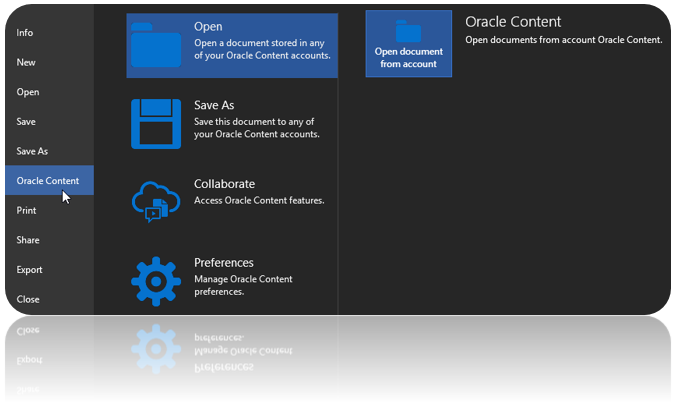
Security – A concern of many businesses considering cloud content management is the safety of their files. Oracle secures files through a multi-layered approach.
- Access to the CEC service requires a username and password managed by a service administrator.
- Files are encrypted through SSL while in storage and transit to the cloud.
- Content owners have access control to the content and folders, which can be customized for different tiers of access. Users who are given access to a file in a folder will not have access to the other files that exist within the folder.
- Service admins have the option to configure virus scans on files upon upload to the cloud. Infected files will be quarantined from the system.
- Passcodes can be set for mobile devices accessing the cloud. Any files downloaded from the cloud will additionally require authentication to the CEC app in order to be decrypted.
- Websites can have security applied to control:
- Individual user/group membership to the published site.
- Who can see the site when it is (un)published.
- Who can see or interact with secured content on the site.
- CEC also include access to analytics, auditing and automatic backups.
Access to Content, and Collaboration – Productivity can suffer when content is difficult to access, or hard to find. Content and Experience Cloud provides availability to content anywhere, with streamlined methods of sharing and collaboration.
- The CEC interface gives users the ability to rapidly collaborate internally or externally by sharing content with other members, or creating public links to folders or files.
- Mobile, tablet, and desktop access out of the box allows users to view and manage content on the go.
- Content can be worked on without internet access, and can be synced to the cloud once you regain connectivity.
- Workflow and review processes allow content to easily and efficiently get published.
- Conversations allow users to comment on files, folders, or digital assets (including the ability to highlight and annotate specific areas of text, and attach files to your comments).
Customizing Your Experience
Oracle provides several expanding development resources that can be used to customize sites on CEC. The modular structure of the site components, and use of modern web libraries and frameworks like RequireJS, KnockoutJS, and Mustache templating help streamline the process of site development, and create a more responsive and rich experience for the end user. I’ve developed a couple proof of concept examples which can serve as a stepping stone to custom enterprise components that are either static, or dynamically accessing files housed in the cloud service.
Custom Component #1: Update Static Content without Coding
Using some of Oracle’s development documentation as a base, the first component I created demonstrates the ability to update static page content through custom settings without touching the code. It utilizes the SitesSDK, which provides a set of functions to integrate custom components with the Oracle Content and Experience Cloud. These functions are particularly helpful in providing storage and retrieval of custom settings used to configure components on the page.
For example, when the component is first set on the page, it will load the default settings values, and render them to the template. While editing the site, you can access the settings in the dropdown menu located on the top right of the component.
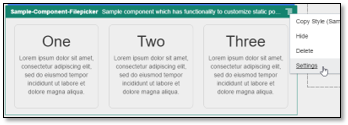
Custom settings were defined for each of the titles and descriptions of the tile elements. By simply updating the input text for each of these fields in the form and pressing enter, the values update immediately on the component within the page. Moreover, when I am happy with the changes I can click “Save” and “Publish”, and those settings will be published to the site and persist for everyone until they need to be changed again. Anyone with permissions to edit the site would be able to update these values in a matter of seconds and publish the changes without any outages. You can see that updating the “Title 1” field to the value “My Title”, and the “Text 1” field to the value “My Description” will update the first tile within the component.
To demonstrate another use of custom settings, I’ve integrated a filepicker that allows the user to navigate files stored in the cloud, and select image to be displayed in the component on the page. Data returned by the SitesSDK can also give us some information on the image, which may be useful depending on the demands of your component. The image, and information about the image will also display immediately on the component so the editor of the site has a preview of the site with the updated component before publishing it to the site for everyone to see.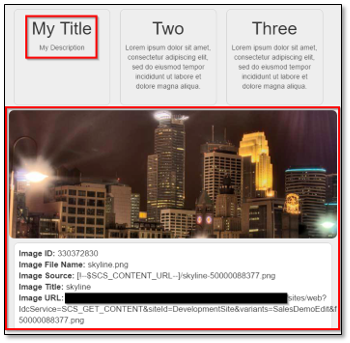
Custom settings provide a great way to manage elements of a page on your site that occasionally need manual changes, and don’t necessarily need to rely on pulling content dynamically from the cloud or another source. It gives site managers flexibility to make changes on the fly, and keep the site fresh and current for its audience.
Custom Component #2: Browser for Cloud Content
The second component I created utilizes Oracle’s Content Management API to build a content browser which displays previews, information, and actions on content living in the cloud. The API provides multiple endpoints to allow viewing, creating, modifying, and deleting folders and files. It can also retrieve information on users in the system. Oracle is working to extend the number and functionality of these endpoints in future releases.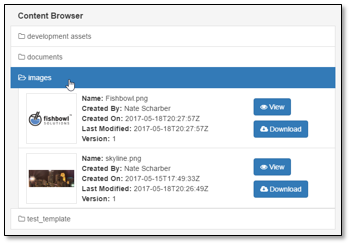
In the above screenshot, you can see the documents view from the CEC interface, and the files that live in the “images” folder. Below is the screenshot of the custom component which grabs all of this information, and renders it to the site. The data returned in the responses make it possible to call for thumbnails of images and documents, as well as build actions like “View” and “Download” to open the full file on the CEC interface, or download the file respectively. This functionality can be used to create components that grab content dynamically and display it to your site as it is contributed to the cloud.
With an enterprise-level account, content administrators will have the ability to define their own structured content with access to Content Types, Content Items, Content Layouts, and Digital Assets. This allows the design of content specific to your business, and opens the door to develop components like a news feed which filters and displays only news content items in a widget on the page, or a search form which can return content filtered on any number of criteria.
Conclusion & Looking to the Future: Integrating with On-Premise and other Back-Office Applications
Oracle Content and Experience Cloud provides an ideal platform for content management in the cloud. It aggregates content, digital assets, conversations, and sites to a single location, where power users can delegate access to the people who need it, anywhere. Surface your content to sites on the cloud using custom components to build an interface that works for your business. Make updates quickly to provide always-current information without modifying site code, or taking the system offline. Oracle continues to improve and expand on the API endpoints and other development materials with future releases.
I will be working to integrate some of Fishbowl Solutions’ SPA taskflows into custom components for display on CEC Sites similar to what I’ve shown in the previous section, except the taskflow code will be hooked into an existing on-premise WebCenter Content instance to serve back content housed in a locally managed database rather than the Document Cloud Service. This will provide options to businesses looking to transition to the cloud service for benefits like site servers being hosted on the cloud, simple site/component management, and near-instant publishing, while still maintaining all the same content on-prem.
Another integration planned for future development is integration with the AuraPlayer service. AuraPlayer provides the ability to wrap existing Oracle Forms/EBS systems as web services which can eventually be surfaced on an Oracle Content and Experience Cloud site as a modern, mobile-friendly, responsive UI. With CEC already accessible by tablet and mobile devices, it stands out as a strong platform candidate.

